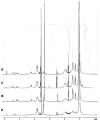Temperature-responsive biocompatible copolymers incorporating hyperbranched polyglycerols for adjustable functionality
- PMID: 22059116
- PMCID: PMC3208240
- DOI: 10.3390/jfb2030173
Temperature-responsive biocompatible copolymers incorporating hyperbranched polyglycerols for adjustable functionality
Abstract
Temperature-triggered copolymers are proposed for a number of bio-applications but there is no ideal material platform, especially for injectable drug delivery. Options are needed for degradable biomaterials that not only respond to temperature but also easily accommodate linkage of active molecules. A first step toward realizing this goal is the design and synthesis of the novel materials reported herein. A multifunctional macromer, methacrylated hyperbranched polyglycerol (HPG-MA) with an average of one acrylate unit per copolymer, was synthesized and copolymerized with N-isopropylacrylamide (NIPAAm), hydroxyethyl methacrylate-polylactide (HEMAPLA) and acrylic acid (AAc). The potential to fully exploit the copolymers by modification of the multiple HPG hydroxyl groups will not be discussed here. Instead, this report focuses on the thermoresponsive, biocompatible, and degradation properties of the material. Poly(NIPAAm-co-HEMAPLA-co-AAc-co-HPG-MA) displayed increasing lower critical solution temperatures (LCST) as the HPG content increased over a range of macromer ratios. For the copolymer with the maximum HPG incorporation (17%), the LCST was ~30 °C. In addition, this sample showed no toxicity when human uterine fibroid cells were co-cultured with the copolymer for up to 72 h. This copolymer lost approximately 92% of its mass after 17 hours at 37 °C. Thus, the reported biomaterials offer attractive properties for the design of drug delivery systems where orthogonally triggered mechanisms of therapeutic release in relatively short time periods would be attractive.
Figures















References
-
- Huang X., Misra G.P., Vaish A., Flanagan J.M., Sutermaster B., Lowe T.L. Novel nanogels with both thermoreponsive and hydrolytically degradable properties. Macromolecules. 2008;41:8339–8345.
-
- Rubio-Retama J., Zafeiropoulos N.E., Serafinelli C., Rojas-Reyna R., Voit B., Cabarcos E.L., Stamm M. Synthesis and characterization of thermosensitive PNIPAM microgels covered with superparamagnetic gamma-Fe2O3 nanoparticles. Langmuir. 2007;23:10280–10285. - PubMed
-
- Ruel-Gariepy E., Leroux J.C. In situ-forming hydrogels-review of temperature-sensitive systems. Eur. J. Pharm. Biopharm. 2004;58:409–426. - PubMed
-
- Al-Tahami K., Singh J. Smart polymer based delivery systems for peptides and proteins. Recent Patents Drug Deliv. Formulation. 2007;1:65–71. - PubMed
-
- Geever L.M., Devine D.M., Nugent M.J.D., Kennedy J.E., Lyons J.G., Higginbotham C.L. The synthesis, characterisation, phase behaviour and swelling of temperature sensitive physically crosslinked poly(1-vinyl-2-pyrrolidinone)/poly(N-isopropylacrylamide) hydrogels. Eur. Polym. J. 2006;42:69–80.
Grants and funding
LinkOut - more resources
Full Text Sources
Other Literature Sources
